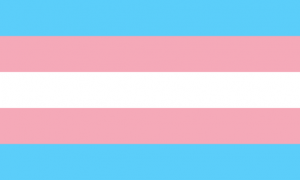20 Gender in Young Adulthood
Sex refers to physical or physiological differences between males, females, and intersex persons, including both their primary and secondary sex characteristics. Gender, on the other hand, refers to social or cultural distinctions associated with a given sex. When babies are born, they are assigned a gender based on their biological sex, male babies are assigned as boys, female babies are assigned as girls, and intersex babies are usually relegated into one category or another. Scholars generally regard gender as a social construct, meaning that it does not exist naturally, but is instead a concept that is created by cultural and societal norms. From birth, children are socialized to conform to certain gender roles based on their biological sex and the gender to which they are assigned.
Since the term sex refers to biological or physical distinctions, characteristics of sex will not vary significantly between different human societies. For example, persons of the female sex, in general, regardless of culture, will eventually menstruate and develop breasts that can lactate. Characteristics of gender, on the other hand, may vary greatly between different societies. For example, in the current majority Canadian and American cultures, it is considered feminine to wear a dress or skirt. However, in many Middle Eastern, Asian, and African cultures, dresses or skirts (often referred to as sarongs, robes, or gowns) can be considered masculine. Similarly, the kilt worn by a Scottish male does not make him appear feminine in his culture.

Gender identity is a person’s sense of self as a member of a particular gender. Individuals who identify with a role that corresponds to the sex assigned to them at birth (for example, they were born with male sex characteristics, were assigned as a boy, and identify today as a boy or man) are cisgender. Those who identify with a role that is different from their biological sex (for example, they were born with male sex characteristics, were assigned as a boy, but identify today as a girl, woman, or some other gender altogether) are often referred to as transgender.
The term transgender encompasses a wide range of possible identities, including agender, genderfluid, genderqueer (signifying gender experiences that do not fit into a binary concept), androgynous, bigender, pangender, ambigender, non-gendered, and intergender, Two-spirit is a modern umbrella term used by some indigenous North Americans to describe gender-variant individuals in their communities.
Transgender is independent of sexual orientation; transgender people may identify as heterosexual, homosexual, bisexual, pansexual, polysexual, asexual, or any other kind of sexuality, just like cisgender people do. It is difficult to determine the prevalence of transgender people in society; however, it is estimated that 700,000 individuals in the United States (0.3%) are transgender (Gates, 2011).
Some transgender individuals may alter their bodies through medical interventions, such as surgery and hormonal therapy, so that their physical being is better aligned with gender identity. Not all transgender individuals choose to alter their bodies or physically transition. Many will maintain their original anatomy, but may present themselves to society as a different gender, often by adopting the dress, hairstyle, mannerisms, or other characteristics typically assigned to a certain gender. It is important to note that people who cross-dress, or wear clothing that is traditionally assigned to the opposite gender, such as transvestites, drag kings, and drag queens, do not necessarily identify as transgender (though some do). People often confuse the term transvestite, which is the practice of dressing and acting in a style or manner traditionally associated with another sex, with transgender. Cross-dressing is typically a form of self-expression, entertainment, or personal style, and not necessarily an expression about one’s gender identity.
Transgender Discrimination
Transgender people are much more likely to experience harassment, bullying, and violence based on their gender identity; they also experience much higher rates of discrimination in housing, employment, healthcare, and education (National Center for Transgender Equality, 2015). Transgender individuals of color face additional financial, social, and interpersonal challenges, in comparison to the transgender community as a whole, as a result of structural racism. Specifically, black transgender people reported the highest level of discrimination among all transgender individuals of color. As members of several intersecting minority groups, transgender people of color, and transgender women of color in particular, are especially vulnerable to employment discrimination, poor health outcomes, harassment, and violence. Consequently, they face even greater obstacles than white transgender individuals and cisgender members of their own race.
Gender Roles

As we grow, we learn how to behave from those around us. In this socialization process, children are introduced to certain roles that are typically linked to their biological sex. The term gender role refers to society’s concept of how men and women are expected to act and behave. Gender roles are based on norms, or standards, created by society. In American culture, masculine roles have traditionally been associated with strength, aggression, and dominance, while feminine roles have traditionally been associated with passivity, nurturing, and subordination.
The drive to adhere to masculine and feminine gender roles continues throughout life. Men tend to outnumber women in professions such as law enforcement, the military, and politics; women tend to outnumber men in care-related occupations such as childcare, healthcare, and social work. These occupational roles are examples of typical American male and female behavior, derived not from biology or genetics, but from our culture’s traditions. Adherence to these roles demonstrates fulfillment of social expectations, but not necessarily personal preference (Diamond, 2002).
Text in this chapter taken directly from Lally & Valentine-French (2017). Figures were curated by O’Neil, McCarthy, & Williams.
Media Attributions
- 040-TransFlag © Monica Helms is licensed under a Public Domain license
- 041-GoodHousekeeping © John Cecil Clay is licensed under a Public Domain license
the traits that distinguish between males and females. Sex refers especially to physical and biological traits, whereas gender refers especially to social or cultural traits, although the distinction between the two terms is not regularly observed. (quoted directly from APA Dictionary of Psychology, undated)
the condition of being male, female, or neuter. In a human context, the distinction between gender and sex reflects the usage of these terms: Sex usually refers to the biological aspects of maleness or femaleness, whereas gender implies the psychological, behavioral, social, and cultural aspects of being male or female (i.e., masculinity or femininity). (quoted directly from APA Dictionary of Psychology, undated)
one’s self-identification as male or female. Although the dominant approach in psychology for many years had been to regard gender identity as residing in individuals, the important influence of societal structures, cultural expectations, and personal interactions in its development is now recognized as well. Significant evidence now exists to support the conceptualization of gender identity as influenced by both environmental and biological factors. (quoted directly from APA Dictionary of Psychology, undated)
having or relating to a gender identity that corresponds to the culturally determined gender roles for one’s birth sex (i.e., the biological sex one was born with). A cisgender man or cisgender woman is thus one whose internal gender identity matches, and presents itself in accordance with, the externally determined cultural expectations of the behavior and roles considered appropriate for one’s sex as male or female. (quoted from APA Dictionary of Psychology, undated)
having or relating to a gender identity that differs from the culturally determined gender roles for one’s birth sex (i.e., the biological sex one was born with) or for one’s sex as surgically assigned at birth. Transgender identities include transsexualism, some forms of transvestism, and intersex. These identities should not be confused with sexual orientation. (quoted directly from APA Dictionary of Psychology, undated)
in some Native American cultures, a person who takes on the gender identity of the opposite sex with the approval of the culture. The culture often views such individuals as having a special spiritual or guiding role in the community. In the Navajo culture, such a person is termed a nadle; in the Lakota culture, the term winkte is used; and in other cultures, a literal translation of “man-woman” might be used. The traditional scholarly term berdache is now used less frequently because of its negative implications of male prostitution or of a “kept” status. (quoted directly from APA Dictionary of Psychology, undated)
an outdated term referring to people who wear the clothes of, and act in a manner traditionally associated with, another sex.
the pattern of behavior, personality traits, and attitudes that define masculinity or femininity in a particular culture. It frequently is considered the external manifestation of the internalized gender identity, although the two are not necessarily consistent with one another.

